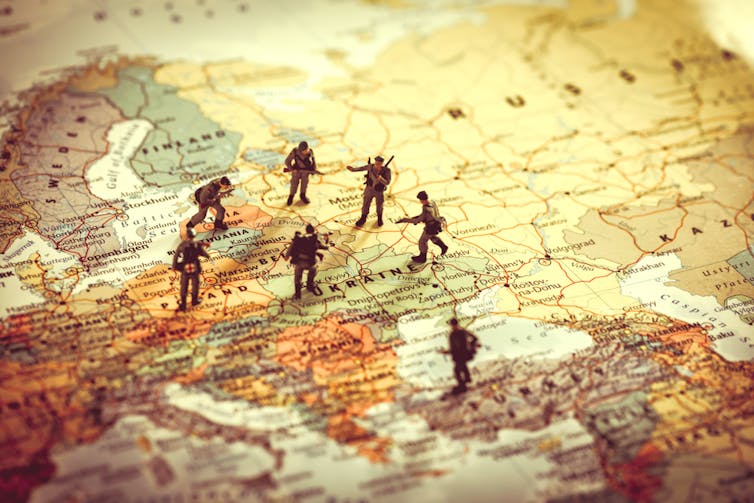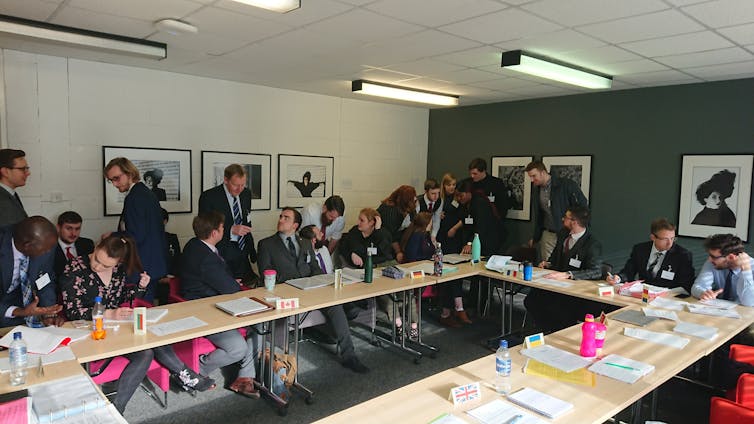
Holger Nehring, University of Stirling and Megan Dee, University of Stirling
It is 9am on a chilly March morning. Delegates from across the world have assembled for an emergency meeting of the North Atlantic Council, NATO’s main decision-making body. The main item on the agenda: an update from the Supreme Allied Commander Europe on Russian escalations in Ukraine and elsewhere in Europe, to determine NATO’s response.
No one doubts the gravity of the situation. Russian forces are moving west to occupy parts of Ukraine beyond the Donbas region and the Crimea. There have also been severe Russian cyber attacks on German infrastructure, while Vladimir Putin has threatened to invade Estonia. NATO’s secretary general has asked one of his predecessors, Lord Robertson of Port Ellen, to join the meeting and share advice.
Do not adjust your set: this meeting took place, but it was a simulation – set in a very near future in which the Ukraine has joined NATO and the UK has left the EU.
These kinds of exercise are conducted regularly by NATO and national armies to anticipate what might happen in the “fog of war”. Standing in for the NATO headquarters in Brussels on this occasion was the University of Stirling in central Scotland. The delegates were students on the university’s masters programme in international conflict and cooperation, and the doctorate in diplomacy.
Lord Robertson was the only person playing himself. He briefed delegates under Chatham House rules on his time chairing NATO, including the historic decision on September 12, 2001 to invoke collective defensive action under Article 5 of the founding treaty.

Immersed in NATO’s engine room, our delegates had to strike a balance during two days of negotiations between countries advocating conflict resolution and those inclined to deterrence – if not pre-emptive action. As well as informing the students’ learning, it produced the following insights for the real world.
1. Russian capabilities
Delegates had to assess Russian defensive capabilities using real-life data. They concluded that while Russia looks strong on a country-by-country comparison, its armed forces remain stretched and are sometimes poorly equipped. Russia would probably not be able to sustain a war with NATO troops over several months, and would likely be challenged by fighting on two fronts.
Having said that, the country’s forces have recently modernised, making them more effective than a few years ago. Russia is also closer than most NATO powers to Ukraine and the Baltics, so could mobilise more quickly and potentially gain strategic advantages.
NATO action in Ukraine would be complicated by a low bridge that Russia has opened connecting Crimea to the Russian mainland. This makes it difficult for larger ships to move between Ukraine’s Black Sea ports and the Mediterranean. Russian expertise in cyber attacks and creating confusion by spreading fake news could also create disunity among NATO members.
Takeaway: the Russian bear is frail but can still bite.
2. Expect complexity
Countries in our simulation negotiated according to national interests. The multilateral negotiation splintered into smaller discussions as mini-alliances emerged. For example, Turkey – with its improving relations with Russia and exposure to potential refugees – was so conciliatory to Moscow that its NATO membership became questionable.
On the other side of the spectrum, Ukraine and also Romania, which feels threatened by Russian aggression in the Black Sea region, sought immediate offensive action. Alliances like these weren’t always visible to the outside world. They complicated negotiations, especially when such countries had essentially non-negotiable aims.

Takeaway: things are not always what they seem, even within a negotiation. Try and stay flexible, and don’t rely on media reports about counterparts’ interests.
3. Events, events, events
Just like in real life, our delegates had to keep monitoring an internal news feed. In one announcement, Russia began mobilising after hard-line statements from certain NATO members leaked to the media on day one of the negotiation. Several times, discussions had to start from scratch as delegations changed priorities and strategies.
Takeaway: constantly ask yourself how events affect your own position and those of your counterparts.
4. Clarity under pressure
With full military intervention and occupation of Ukraine by Russia on the cards by the middle of day two, NATO allies had to deploy ground troops or risk ceding ground to Moscow. Issues agonised over the day before became less relevant as delegations were forced to compromise in the interests of collective action.
Takeaway: time pressure can make decision-making hot-headed, but can lead to clarity of purpose. Negotiators who understand this can use it to their advantage.
5. EU security
As EU members of our fictional North Atlantic Council discussed issues among themselves, we witnessed how the EU has become a geopolitical actor with “state-like” qualities. Before committing to security actions through NATO, EU members negotiated with each other and sought a coherent position.

One important dimension in the real world is the EU’s Russia sanctions, which are slightly different to US sanctions. With Ukraine now also party to an EU Association Agreement, the EU is demonstrating its capability to project power abroad.
Takeaway: the EU is developing its own geopolitical and security role in Europe, with potential consequences for NATO.
6. The UK squeeze
Within NATO, the UK has generally mediated between the US and usually softer EU positions. Our simulation showed that after Brexit, despite its important role as a nuclear-armed NATO member, the UK will likely feel squeezed between the US and EU.
Takeaway: the implications of Brexit for the UK in NATO deserve more attention.
7. Refugee risks
In our simulation NATO members closer to Russia, such as Poland and Hungary, were particularly worried that military action in Ukraine would lead to a large number of refugees – with potentially serious domestic political consequences.
Takeaway: we don’t always take enough account of the linkages between military and human security.
8. Take positive decisions
When the BBC war-gamed a similar scenario several years ago, the UK got drawn into a nuclear war. Our fictional delegates managed to avoid such awful outcomes by using what deterrent power they had. They combined mobilisation with the offer of talks in such a way that Russia backed off. Despite some hawkish pressure, the situation was mostly defused by dominant countries such as the US as well as conciliatory EU voices.
Takeaway: On March 18, on the fifth anniversary of annexation, NATO reiterated its view that Crimea is Ukrainian territory. Meanwhile, hostilities continue in Donbas. The apparent stalemate in Ukraine could change overnight – not least with the presidential election at the end of March. If so, NATO members will have to make a choice, despite the fact that Ukraine is not currently a member of the alliance. As became clear to our participants, the one thing you can’t do in a moment of international crisis is to refuse to act if your interests are at stake.
Holger Nehring, Professor in Contemporary European History, University of Stirling and Megan Dee, Lecturer in International Politics, University of Stirling
This article is republished from The Conversation under a Creative Commons license. Read the original article.
